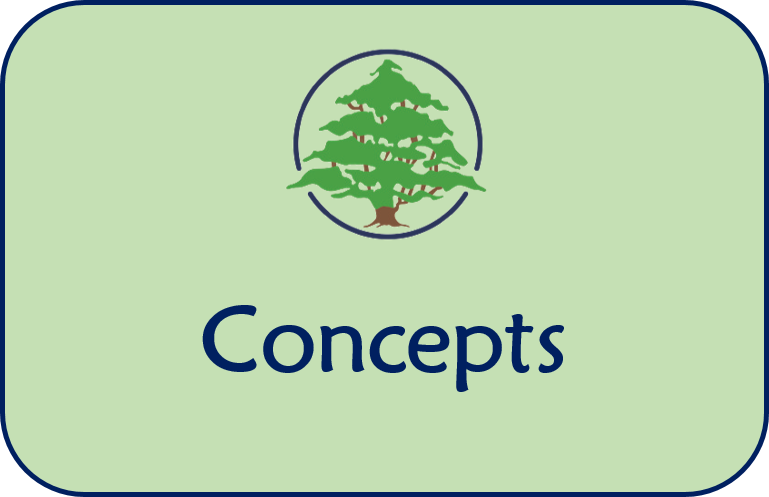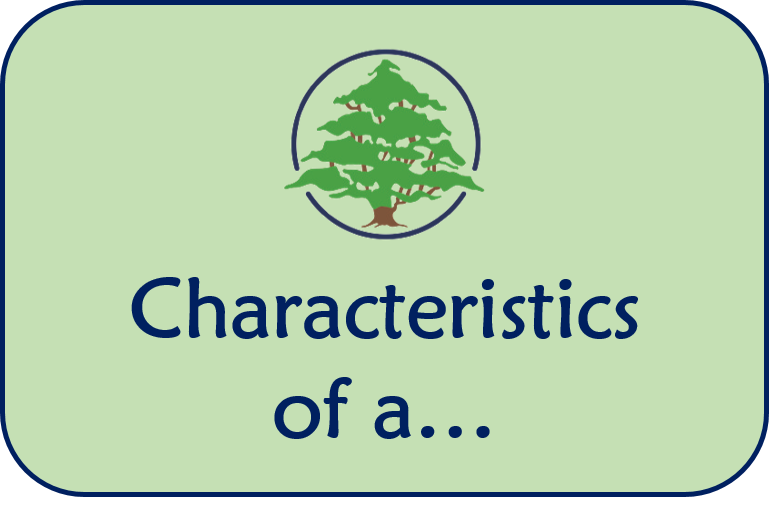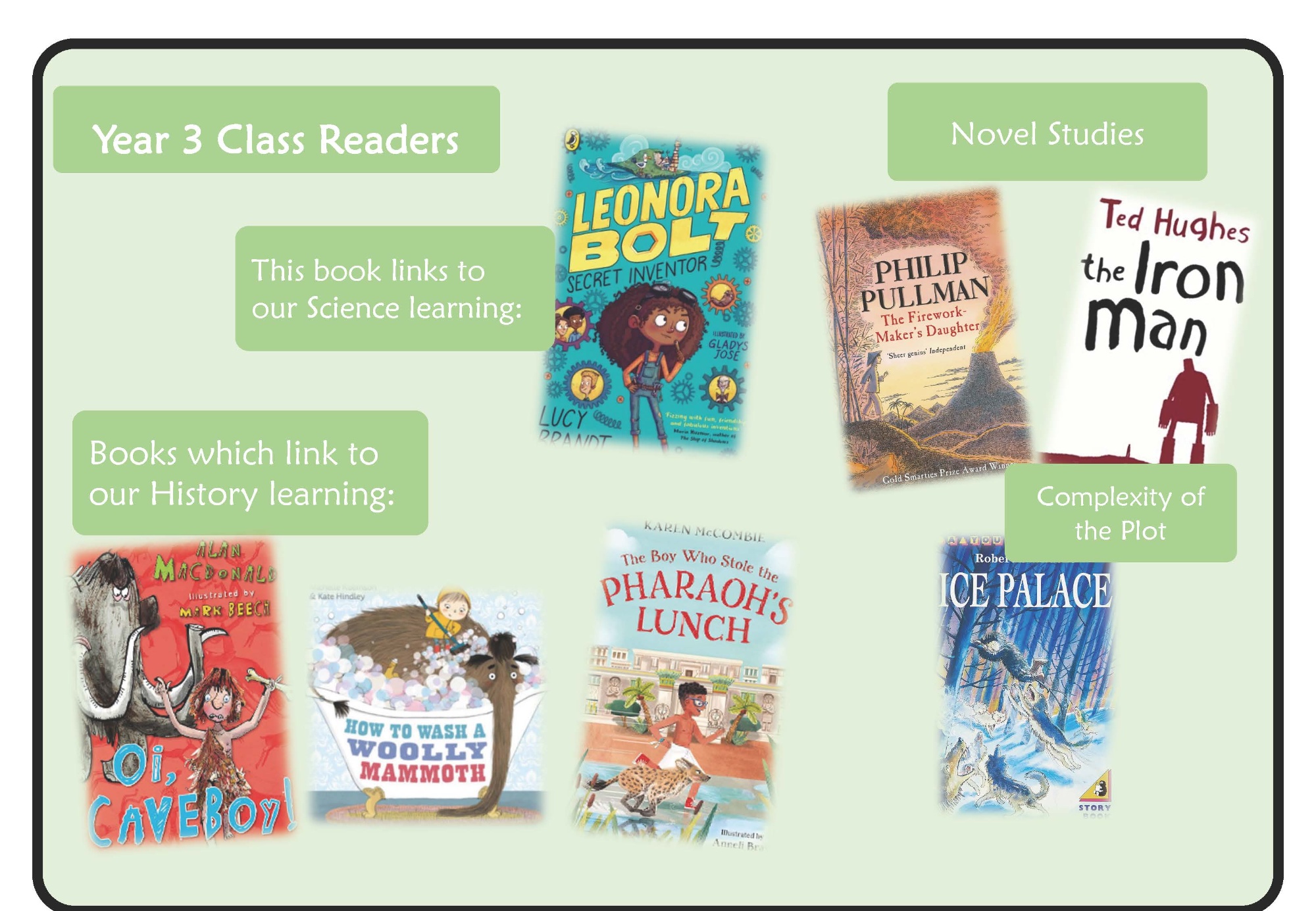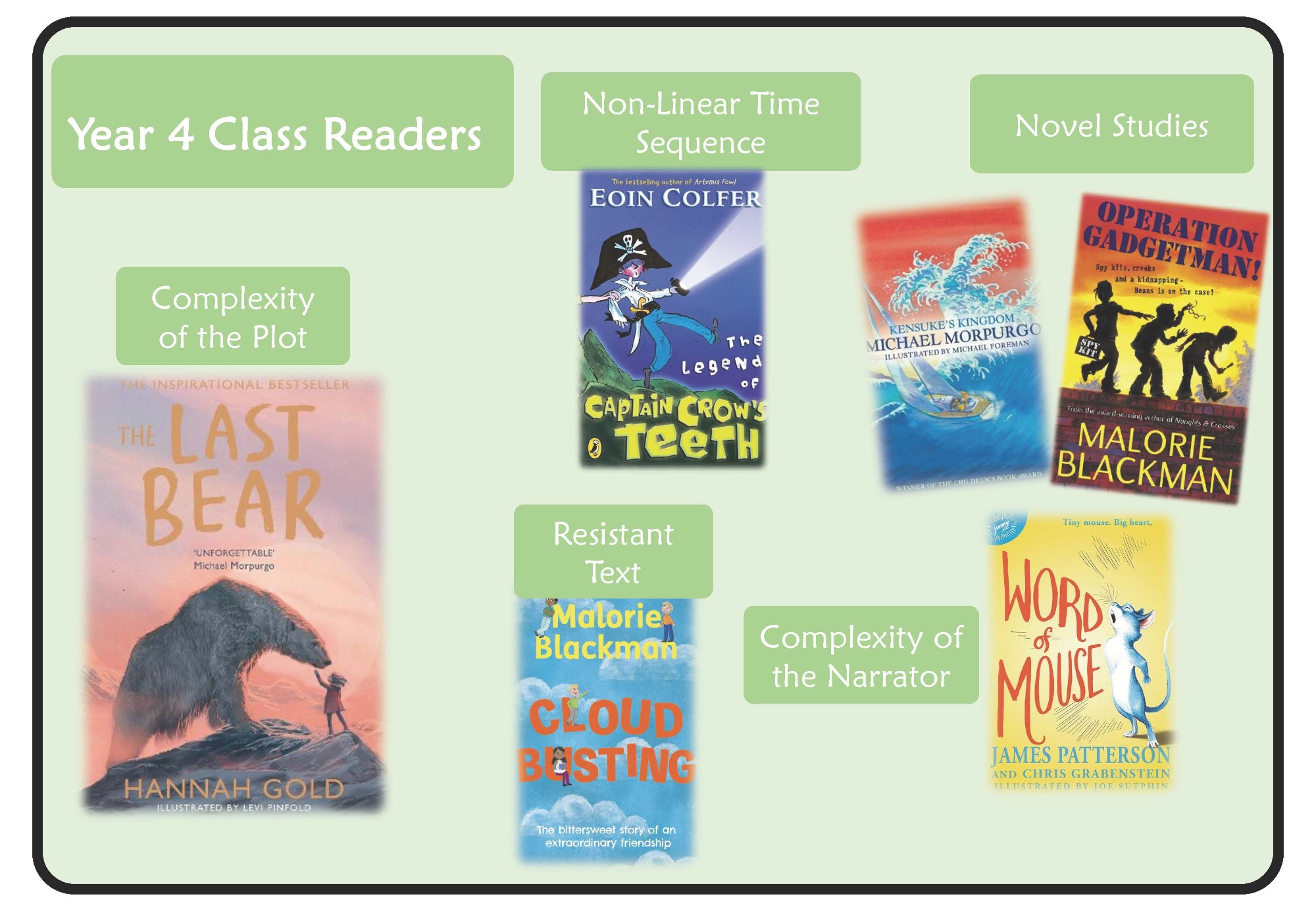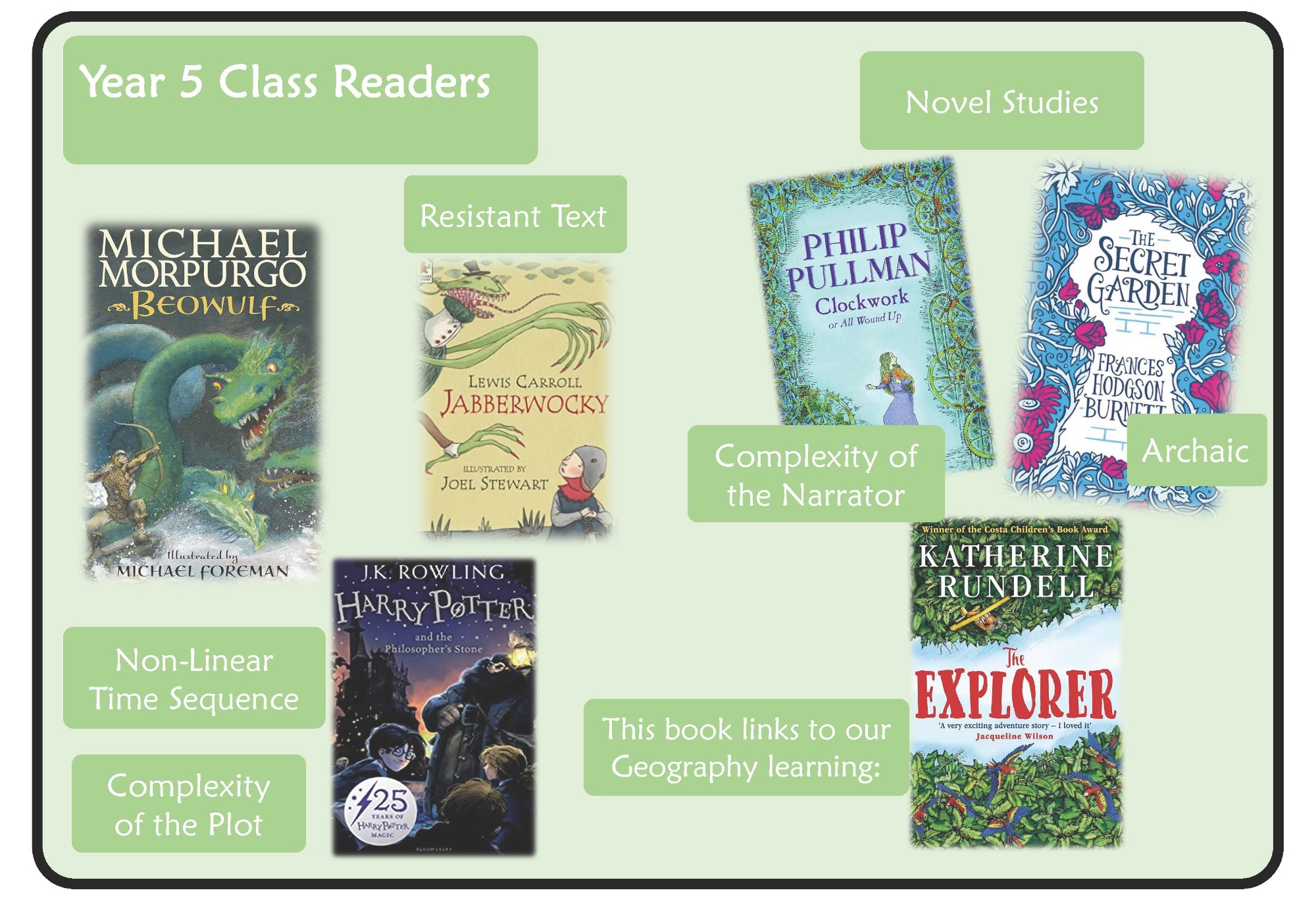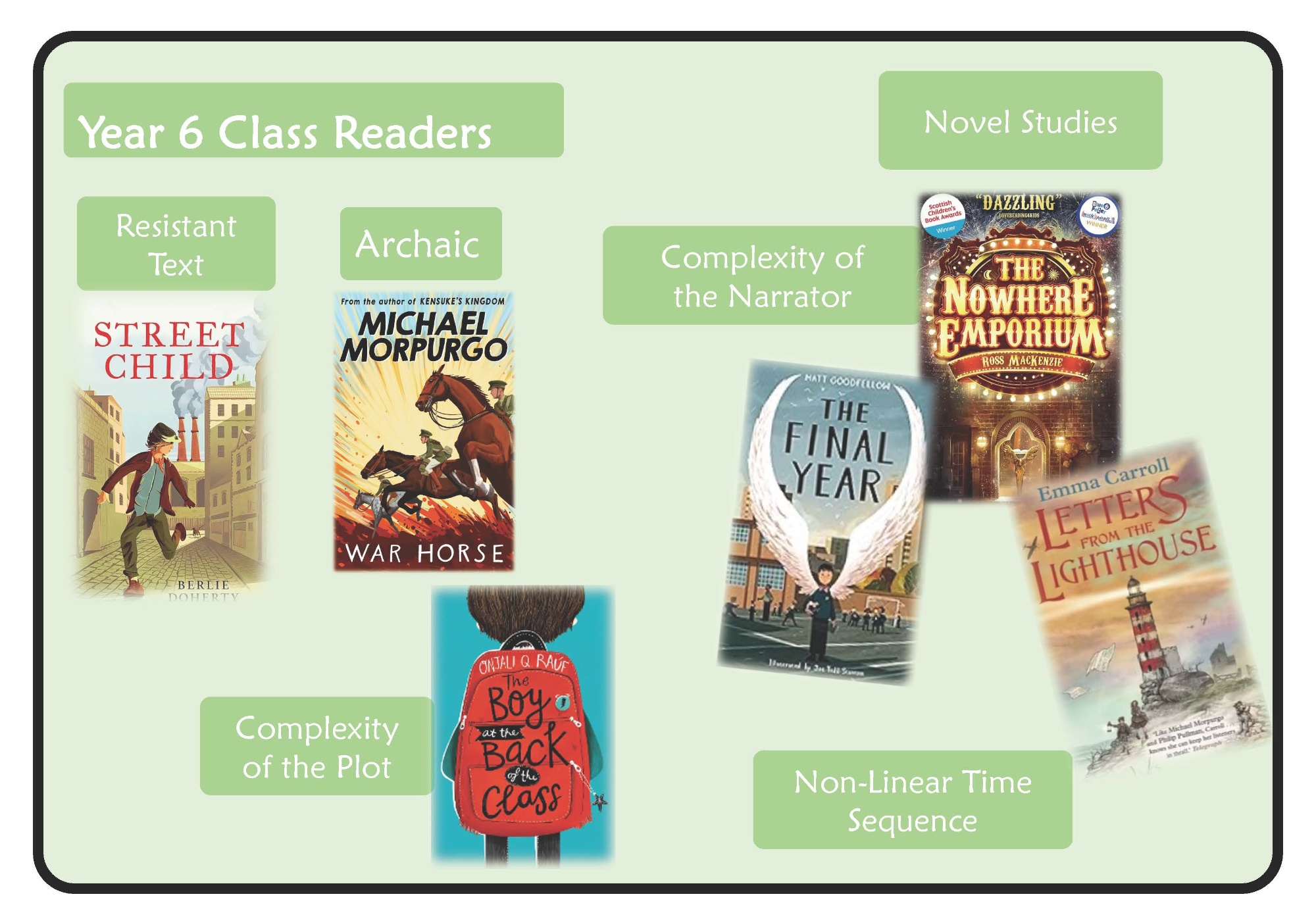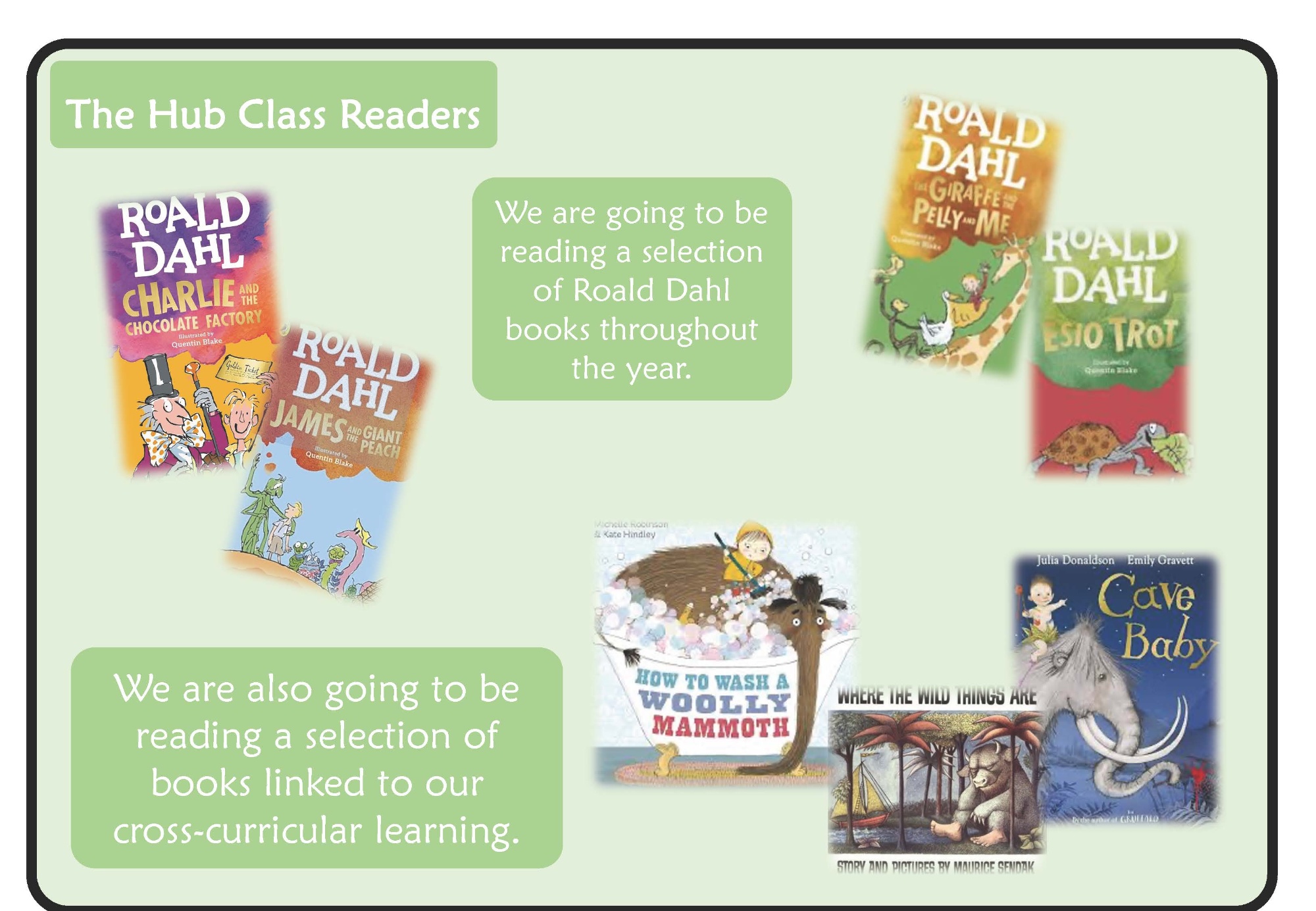English - Reading
Reading at Stocksbridge Junior School
Central to our reading curriculum is the belief that every child will achieve their potential in reading and the wider curriculum. Our vision is that all pupils become fluent, confident readers who develop a lifelong love of reading. Through the teaching of high-quality texts, children’s thinking is challenged, their knowledge of the wider world and vocabulary is broadened, and they are able to make connections and interpret meaning from texts. Our aim is that reading for pleasure will become habitual for all of our pupils. We want our pupils to utilise their reading skills to enable them to access all parts of the curriculum throughout their time in key stage 2 and beyond. Through our reading curriculum, we want pupils to develop an appreciation of literature produced by a range of authors and poets.
Intent
Our teaching of reading is ambitious and our intention is that all pupils experience a wide breadth of study and develop a long-term memory of the procedures, techniques and language used in reading. We propose to foster children’s curiosity to explore the work of authors and poets, who, throughout history, to the present day, have created literature that has shaped and challenged thinking. Our curriculum enables our pupils to develop their knowledge of these authors and literature.
Comprehension skills are taught through direct reading instruction during daily reading lessons. Further opportunities are given for pupils to apply their reading skills; during independent reading time, through the delivery of the class read and in other curriculum subjects where pupils are accessing texts. Through the practical application of reading skills, pupils experience reading a range of texts and develop their skills in both word reading and understanding texts.
At the heart of our reading curriculum is the principle that all children are able to engage with the learning for their year group. Through the pre-teaching of background knowledge and vocabulary, and the repetition and revisiting of key skills, all pupils are able to access high-quality, challenging texts. The sequence of the reading lessons enables pupils to practise their skills and make progress.
We want all of our pupils to develop the following skills:
- Excellent phonic knowledge and skills.
- Fluency and accuracy in reading across a wide range of contexts throughout the curriculum.
- Knowledge of an extensive and rich vocabulary.
- An excellent comprehension of texts.
- The motivation to read for both study and for pleasure.
- Extensive knowledge through having read a rich and varied range of texts.
Through our curriculum, we ensure that our pupils enter and leave a significant stage in their academic journey and social and emotional development fully prepared for the next phase in their lives. It is our commitment that our children are accessing a curriculum that will meet, and exceed, the requirements of the national curriculum through key concepts and ambitious end points. Every pupil, regardless of social disadvantage and SEND, is entitled to an ambitious curriculum. Where required, carefully designed support will identify and address gaps in knowledge and skills so that every child is successful.
Implementation
Underpinning our reading curriculum are the two key concepts:
- Word recognition
- Language comprehension
Through the teaching of word recognition, through reading and English lessons as well as phonics interventions, children become fluent, accurate readers who demonstrate stamina for reading. Pupils who have gaps in their phonics are identified quickly and targeted interventions ensure that no child is left behind in their reading journey.
Reading skills are taught daily and are practised and embedded throughout the rest of the curriculum. In order to enable all pupils to build on their reading skills, reading lessons are taught sequentially in increasing complexity. Pupils have opportunities to regularly re-visit and build on skills so that they become embedded. In terms 1a, 2a and 3a, children are taught the skills of comprehension whilst reading a range of extracts.
The five key comprehension skills through which extract half-terms are structured are:
- Activating background knowledge
- Developing new vocabulary
- ‘Read aloud, think aloud’ using skills such as inference and prediction
- Visualising
- Comprehension
In terms 1b, 2b and 3b, pupils apply the comprehension skills they have been taught in the previous half-terms as they undertake novel studies. Alternating between reading extracts and novel study enables pupils to experience a breadth of authors and text types, and to delve deeper into longer texts during their novel study. Texts are sequenced from Year 3 to Year 6 by increasing complexity, allowing all pupils to be challenged as they move through school. Children build on their reading skills by regularly revisiting objectives and applying them to different contexts. Cross-curricular links are made through some texts to allow children to bring their own background knowledge to their reading experience and widen it.
Reading journals are used during reading lessons to allow our pupils the opportunity to showcase their reading skills. Interwoven throughout each lesson are assessment opportunities to monitor the learning of all our pupils, so that opportunities to offer support and challenge are fully utilised to ensure pupil progression for all. Fluency skills are modelled and practised daily to allow pupils to develop their skills in fluency, with a focus on expression and volume, smoothness, phrasing and pace.
In addition to the reading teaching sequence, pupils experience and enjoy a range of inspiring texts through their daily class reader, taken from our reading spine, which is read by the teacher.
Our reading spine has been chosen from ‘The 5 Plagues of Reading’ in order to ensure that all pupils can experience a range of challenging text types. Class readers are categorised under the following headings:
- Archaic text
- Complexity of the plot
- Complexity of the narrator
- Non-linear time sequence
- Resistant text
These carefully selected texts enable pupils to become familiar with a range of high-quality literature and help pupils to expand their vocabulary and imagination as well as their love for reading.
‘Reading for pleasure is the single most important indicator of a child’s future success’. (OECD, 2002)
We understand the wide range of benefits which come from pupils reading for pleasure. Independent reading time provides opportunities for children to explore their class reading corners, enjoy reading books of their choice and blether about their books with their peers and teachers. Children who continue their positive reading habits at home are able to earn postcards which take them on different journeys across the world. In addition, children use Accelerated Reader to take reading quizzes on their books and myON to access a range of e-books, both at home and at school. Pupils enjoy taking their reading journey further by visiting our very own Reading Bus to discover and read books beyond their classroom library.
Impact
At Stocksbridge Junior School, our pupils develop and extend their learning in reading throughout the whole key stage. As skills are revisited and extended, there are many opportunities for previously learned information to be retrieved, aiding their long-term learning of the concepts, skills and procedures taught in the reading curriculum. Children’s progress in reading is closely monitored, enabling the correct support to be put in place for our pupils.
Half-termly assessments are used to measure the impact that teaching has had on pupils’ reading progress.
- At the end of Term 1a, 2a and 3a, pupils are assessed using Star Reading assessments. This assessment provides pupils with an up-to-date ZPD (Zone of Proximal Development) which supports them in selecting reading books independently and also provides teachers with information around their gaps and targets.
- At the end of each term, (1b, 2b and 3b) pupils are assessed using the NTS Reading Assessments. This enables teachers to closely monitor pupils’ progress across the reading domains and to plan accordingly based on these assessments.
- Pupils accessing direct phonics teaching are assessed regularly using the Little Wandle Letters and Sounds revised assessment.
On-going formative assessment is used by teachers in various ways, by:
- Hearing pupils read.
- Teaching reading lessons.
- Monitoring pupils’ use of Accelerated Reader and their quiz results.
- Pupils taking part in reading for pleasure time.
- Questioning pupils during reading sessions.
- Talking to pupils about their reading and books in common.
Through our reading curriculum, our pupils develop the ability to discuss and compare different texts, identify key themes and make links between different plots and characters. We encourage our pupils to actively engage in their learning journey in reading through high-quality discussions of texts. Children develop the confidence to explain their ideas and express an opinion about books that they have read. As they complete the end of the key stage at Stocksbridge Junior School, through skilful teaching, insightful assessment and carefully designed support, all of our pupils will have acquired the essential knowledge and skills that are the firm foundations upon which to build upon and continue their learning journey as readers.
The reading lead regularly talks to pupils as part of regular monitoring in order find out what they have learnt and what has been remembered. The purpose of this is to also gain an idea of pupils’ enjoyment of reading, so that any improvements or changes can be made to the reading curriculum.
Stocksbridge Junior School Curriculum for Reading
Reading Information Leaflets for Parents:
Phonics at Stocksbridge Junior School
Phonics is a way of teaching children to read quickly and skilfully. Pupils are taught how to:
- Recognise the sounds that each individual letter makes.
- Identify the sounds that different combinations of letters make – such as /sh/ or /oo/.
- Blend these sounds together from left to right to make a word.
Children can then use this knowledge to ‘de-code’ new words that they hear or see. This is the first important step in learning to read. Research shows that when phonics is taught in a structured way – starting with the easiest sounds and progressing through to the most complex – it is the most effective way of teaching young children to read. Almost all children who receive good teaching of phonics will learn the skills they need to tackle new words. They can then go on to read any kind of text fluently and confidently, and to read for enjoyment.
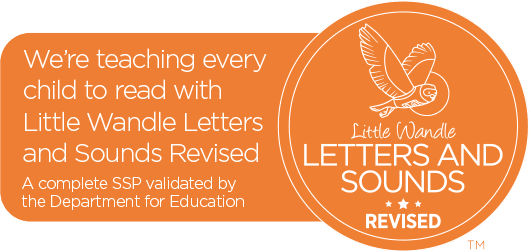
Intent
Having a secure knowledge of phonics is vital to enable our pupils to read and write independently. If children enter KS2 with gaps in their phonics learning, we take swift action to ensure that they are accurately assessed and interventions are put in place to address the identified gaps.
“Pupils who are still struggling to decode need to be taught to do this urgently through a rigorous and systematic phonics programme so that they catch up rapidly with their peers. If they cannot decode independently and fluently, they will find it increasingly difficult to understand what they read and to write down what they want to say.” (National Curriculum 2014)
This is why we teach phonics through Little Wandle Letters and Sounds Revised, which is a systematic and synthetic phonics programme. This approach ensures that children build on their growing knowledge of the alphabetic code, mastering phonics to read and spell as they move through school.
Phonics Implementation
Any child who joins us in Year 3 requiring additional phonics teaching, receives daily phonics lessons, taught by a fully trained adult.
- We timetable daily phonics lessons for children who have gaps in their phonics and/or have not passed the phonics screening check. These children urgently need to catch up, so the gap between themselves and their peers does not widen. Little Wandle Letters and Sounds Revised assessments are used to identify the gaps in their phonic knowledge and teach to these. Assessments are completed at least every half-term to ensure that the gaps in their phonic knowledge are rapidly closing.
- Reading practice sessions are also used to enable pupils to apply their phonic skills.
Reading practice sessions:
- Are taught by a fully trained adult to small groups of children.
- Use books matched to the children’s secure phonic knowledge using the Little Wandle Letters and Sounds Revised assessments and book matching grids on pages 11–20 of ‘Application of phonics to reading.’
Each reading practice session has a clear focus, so that the demands of the session do not overload the children’s working memory. The reading practice sessions have been designed to focus on three key reading skills:
- Decoding.
- Prosody: teaching children to read with understanding and expression.
- Comprehension: teaching children to understand the text.
Phonics Impact
Assessment is used to monitor progress and to identify any child needing additional support as soon as they need it.
- Assessment for learning is used:
- Daily within class to identify children needing additional support.
- weekly in the Review lesson to assess gaps, address these immediately and secure fluency of GPCs, words and spellings.
- Summative assessment is used:
- Every six weeks to assess progress, to identify gaps in learning that need to be addressed, to identify any children needing additional support and to plan the support that they need.
- The Little Wandle Letters and Sounds Revised placement assessment is used:
- With any child new to the school, who is not fluent in reading, to quickly identify any gaps in their phonic knowledge and to plan appropriate extra teaching.
Ongoing assessment for catch-up
- Children accessing direct phonics teaching in Year 3 to 6 are assessed through:
- Their teacher’s ongoing formative assessment.
- The Little Wandle Letters and Sounds placement assessment.
Parents and carers can find further information and videos about how to support children with their phonics on the Little Wandle website.
The National Curriculum for English
Purpose of study
English has a pre-eminent place in education and in society. A high-quality education in English will teach pupils to speak and write fluently so that they can communicate their ideas and emotions to others, and through their reading and listening, others can communicate with them. Through reading in particular, pupils have a chance to develop culturally, emotionally, intellectually, socially and spiritually. Literature, especially, plays a key role in such development. Reading also enables pupils both to acquire knowledge and to build on what they already know. All the skills of language are essential to participating fully as a member of society; pupils who do not learn to speak, read and write fluently and confidently are effectively disenfranchised.
Aims
The overarching aim for English in the national curriculum is to promote high standards of language and literacy by equipping pupils with a strong command of the spoken and written language, and to develop their love of literature through widespread reading for enjoyment. The national curriculum for English aims to ensure that all pupils:
- Read easily, fluently and with good understanding.
- Develop the habit of reading widely and often, for both pleasure and information.
- Acquire a wide vocabulary, an understanding of grammar and knowledge of linguistic conventions for reading, writing and spoken language.
- Appreciate our rich and varied literary heritage.
- Write clearly, accurately and coherently, adapting their language and style in and for a range of contexts, purposes and audiences.
- Use discussion in order to learn; they should be able to elaborate and explain clearly their understanding and ideas.
- Are competent in the arts of speaking and listening, making formal presentations, demonstrating to others and participating in debate.
Spoken language
The national curriculum for English reflects the importance of spoken language in pupils’ development across the whole curriculum – cognitively, socially and linguistically. Spoken language underpins the development of reading and writing. The quality and variety of language that pupils hear and speak are vital for developing their vocabulary and grammar and their understanding for reading and writing. Teachers should therefore ensure the continual development of pupils’ confidence and competence in spoken language and listening skills. Pupils should develop a capacity to explain their understanding of books and other reading, and to prepare their ideas before they write. They must be assisted in making their thinking clear to themselves as well as to others, and teachers should ensure that pupils build secure foundations by using discussion to probe and remedy their misconceptions. Pupils should also be taught to understand and use the conventions for discussion and debate.
All pupils should be enabled to participate in and gain knowledge, skills and understanding associated with the artistic practice of drama. Pupils should be able to adopt, create and sustain a range of roles, responding appropriately to others in role. They should have opportunities to improvise, devise and script drama for one another and a range of audiences, as well as to rehearse, refine, share and respond thoughtfully to drama and theatre performances.
Statutory requirements which underpin all aspects of spoken language across the 6 years of primary education form part of the national curriculum. These are reflected and contextualised within the reading and writing domains which follow.
Reading
The programmes of study for reading at key stages 1 and 2 consist of 2 dimensions:
- Word reading.
- Comprehension (both listening and reading).
It is essential that teaching focuses on developing pupils’ competence in both dimensions; different kinds of teaching are needed for each.
Skilled word reading involves both the speedy working out of the pronunciation of unfamiliar printed words (decoding) and the speedy recognition of familiar printed words. Underpinning both is the understanding that the letters on the page represent the sounds in spoken words. This is why phonics should be emphasised in the early teaching of reading to beginners (ie unskilled readers) when they start school.
Good comprehension draws from linguistic knowledge (in particular of vocabulary and grammar) and on knowledge of the world. Comprehension skills develop through pupils’ experience of high-quality discussion with the teacher, as well as from reading and discussing a range of stories, poems and non-fiction. All pupils must be encouraged to read widely across both fiction and non-fiction to develop their knowledge of themselves and the world they live in, to establish an appreciation and love of reading, and to gain knowledge across the curriculum. Reading widely and often increases pupils’ vocabulary because they encounter words they would rarely hear or use in everyday speech. Reading also feeds pupils’ imagination and opens up a treasure house of wonder and joy for curious young minds.
It is essential that, by the end of their primary education, all pupils are able to read fluently, and with confidence, in any subject in their forthcoming secondary education.
Writing
The programmes of study for writing at key stages 1 and 2 are constructed similarly to those for reading:
- Transcription (spelling and handwriting)
- Composition (articulating ideas and structuring them in speech and writing)
It is essential that teaching develops pupils’ competence in these 2 dimensions. In addition, pupils should be taught how to plan, revise and evaluate their writing. These aspects of writing have been incorporated into the programmes of study for composition.
Writing down ideas fluently depends on effective transcription: that is, on spelling quickly and accurately through knowing the relationship between sounds and letters (phonics) and understanding the morphology (word structure) and orthography (spelling structure) of words. Effective composition involves articulating and communicating ideas, and then organising them coherently for a reader. This requires clarity, awareness of the audience, purpose and context, and an increasingly wide knowledge of vocabulary and grammar. Writing also depends on fluent, legible and, eventually, speedy handwriting.
Spelling, vocabulary, grammar, punctuation and glossary
The two statutory appendices – on spelling and on vocabulary, grammar and punctuation – give an overview of the specific features that should be included in teaching the programmes of study.
Opportunities for teachers to enhance pupils’ vocabulary arise naturally from their reading and writing. As vocabulary increases, teachers should show pupils how to understand the relationships between words, how to understand nuances in meaning, and how to develop their understanding of, and ability to use, figurative language. They should also teach pupils how to work out and clarify the meanings of unknown words and words with more than 1 meaning. References to developing pupils’ vocabulary are also included in the appendices.
Pupils should be taught to control their speaking and writing consciously and to use Standard English. They should be taught to use the elements of spelling, grammar, punctuation and ‘language about language’ listed. This is not intended to constrain or restrict teachers’ creativity, but simply to provide the structure on which they can construct exciting lessons. A non-statutory glossary is provided for teachers.
Throughout the programmes of study, teachers should teach pupils the vocabulary they need to discuss their reading, writing and spoken language. It is important that pupils learn the correct grammatical terms in English and that these terms are integrated within teaching.
School curriculum
The programmes of study for English are set out year-by-year for key stage 1 and two-yearly for key stage 2. The single year blocks at key stage 1 reflect the rapid pace of development in word reading during these two years. Schools are, however, only required to teach the relevant programme of study by the end of the key stage. Within each key stage, schools therefore have the flexibility to introduce content earlier or later than set out in the programme of study. In addition, schools can introduce key stage content during an earlier key stage if appropriate. All schools are also required to set out their school curriculum for English on a year-by-year basis and make this information available online.
Spoken language – Years 1 to 6
Spoken language
Pupils should be taught to:
- Listen and respond appropriately to adults and their peers.
- Ask relevant questions to extend their understanding and knowledge.
- Use relevant strategies to build their vocabulary.
- Articulate and justify answers, arguments and opinions.
- Give well-structured descriptions, explanations and narratives for different purposes, including for expressing feelings.
- Maintain attention and participate actively in collaborative conversations, staying on topic and initiating and responding to comments.
- Use spoken language to develop understanding through speculating, hypothesising, imagining and exploring ideas.
- Speak audibly and fluently with an increasing command of Standard English.
- Participate in discussions, presentations, performances, role play/improvisations and debates.
- Gain, maintain and monitor the interest of the listener(s).
- Consider and evaluate different viewpoints, attending to and building on the contributions of others.
- Select and use appropriate registers for effective communication.
Lower key stage 2 – Years 3 and 4
By the beginning of year 3, pupils should be able to read books written at an age-appropriate interest level. They should be able to read them accurately and at a speed that is sufficient for them to focus on understanding what they read rather than on decoding individual words. They should be able to decode most new words outside their spoken vocabulary, making a good approximation to the word’s pronunciation. As their decoding skills become increasingly secure, teaching should be directed more towards developing their vocabulary and the breadth and depth of their reading, making sure that they become independent, fluent and enthusiastic readers who read widely and frequently. They should be developing their understanding and enjoyment of stories, poetry, plays and non-fiction, and learning to read silently. They should also be developing their knowledge and skills in reading non-fiction about a wide range of subjects. They should be learning to justify their views about what they have read: with support at the start of year 3 and increasingly independently by the end of year 4.
Pupils should be able to write down their ideas with a reasonable degree of accuracy and with good sentence punctuation. Teachers should therefore be consolidating pupils’ writing skills, their vocabulary, their grasp of sentence structure and their knowledge of linguistic terminology. Teaching them to develop as writers involves teaching them to enhance the effectiveness of what they write as well as increasing their competence. Teachers should make sure that pupils build on what they have learnt, particularly in terms of the range of their writing and the more varied grammar, vocabulary and narrative structures from which they can draw to express their ideas. Pupils should be beginning to understand how writing can be different from speech. Joined handwriting should be the norm; pupils should be able to use it fast enough to keep pace with what they want to say.
Pupils’ spelling of common words should be correct, including common exception words and other words that they have learnt – see English appendix 1. Pupils should spell words as accurately as possible using their phonic knowledge and other knowledge of spelling, such as morphology and etymology.
Most pupils will not need further direct teaching of word reading skills: they are able to decode unfamiliar words accurately, and need very few repeated experiences of this before the word is stored in such a way that they can read it without overt sound-blending. They should demonstrate understanding of figurative language, distinguish shades of meaning among related words and use age-appropriate, academic vocabulary.
As in key stage 1, however, pupils who are still struggling to decode need to be taught to do this urgently through a rigorous and systematic phonics programme so that they catch up rapidly with their peers. If they cannot decode independently and fluently, they will find it increasingly difficult to understand what they read and to write down what they want to say. As far as possible, however, these pupils should follow the year 3 and 4 programme of study in terms of listening to new books, hearing and learning new vocabulary and grammatical structures, and discussing these.
Specific requirements for pupils to discuss what they are learning and to develop their wider skills in spoken language form part of this programme of study. In years 3 and 4, pupils should become more familiar with and confident in using language in a greater variety of situations, for a variety of audiences and purposes, including through drama, formal presentations and debate.
Years 3 and 4 programme of study
Reading – word reading
Pupils should be taught to:
- Apply their growing knowledge of root words, prefixes and suffixes (etymology and morphology) as listed in – see English appendix 1 , both to read aloud and to understand the meaning of new words they meet.
- Read further exception words, noting the unusual correspondences between spelling and sound, and where these occur in the word.
Reading – comprehension
Pupils should be taught to:
- Develop positive attitudes to reading, and an understanding of what they read, by:
- Listening to and discussing a wide range of fiction, poetry, plays, non-fiction and reference books or textbooks.
- Reading books that are structured in different ways and reading for a range of purposes.
- Using dictionaries to check the meaning of words that they have read.
- Increasing their familiarity with a wide range of books, including fairy stories, myths and legends, and retelling some of these orally.
- Identifying themes and conventions in a wide range of books.
- Preparing poems and play scripts to read aloud and to perform, showing understanding through intonation, tone, volume and action.
- Discussing words and phrases that capture the reader’s interest and imagination.
- Recognising some different forms of poetry [for example, free verse, narrative poetry].
- Understand what they read, in books they can read independently, by:
- Checking that the text makes sense to them, discussing their understanding, and explaining the meaning of words in context.
- Asking questions to improve their understanding of a text.
- Drawing inferences such as inferring characters’ feelings, thoughts and motives from their actions, and justifying inferences with evidence.
- Predicting what might happen from details stated and implied.
- Identifying main ideas drawn from more than one paragraph and summarising these.
- Identifying how language, structure, and presentation contribute to meaning.
- Retrieve and record information from non-fiction.
- Participate in discussion about both books that are read to them and those they can read for themselves, taking turns and listening to what others say.
Writing – transcription
Spelling – see English appendix 1
Pupils should be taught to:
- Use further prefixes and suffixes and understand how to add them – see English appendix 1.
- Spell further homophones.
- Spell words that are often misspelt – see English appendix 1.
- Place the possessive apostrophe accurately in words with regular plurals [for example, girls’, boys’] and in words with irregular plurals [for example, children’s].
- Use the first 2 or 3 letters of a word to check its spelling in a dictionary.
- Write from memory simple sentences, dictated by the teacher, that include words and punctuation taught so far.
Handwriting
Pupils should be taught to:
- Use the diagonal and horizontal strokes that are needed to join letters and understand which letters, when adjacent to one another, are best left unjoined.
- Increase the legibility, consistency and quality of their handwriting, [for example, by ensuring that the downstrokes of letters are parallel and equidistant, and that lines of writing are spaced sufficiently so that the ascenders and descenders of letters do not touch].
Writing – composition
Pupils should be taught to:
- Plan their writing by:
- Discussing writing similar to that which they are planning to write in order to understand and learn from its structure, vocabulary and grammar.
- Discussing and recording ideas.
- Draft and write by:
- Composing and rehearsing sentences orally (including dialogue), progressively building a varied and rich vocabulary and an increasing range of sentence structures English appendix 2.
- Organising paragraphs around a theme.
- In narratives, creating settings, characters and plot.
- In non-narrative material, using simple organisational devices [for example, headings and sub-headings].
- Evaluate and edit by:
- Assessing the effectiveness of their own and others’ writing and suggesting improvements.
- Proposing changes to grammar and vocabulary to improve consistency, including the accurate use of pronouns in sentences.
- Proofread for spelling and punctuation errors.
- Read their own writing aloud to a group or the whole class, using appropriate intonation and controlling the tone and volume so that the meaning is clear.
Writing – vocabulary, grammar and punctuation
Pupils should be taught to:
- Develop their understanding of the concepts set out in English appendix 2 by:
- Extending the range of sentences with more than one clause by using a wider range of conjunctions, including: when, if, because, although.
- Using the present perfect form of verbs in contrast to the past tense.
- Choosing nouns or pronouns appropriately for clarity and cohesion and to avoid repetition.
- Using conjunctions, adverbs and prepositions to express time and cause.
- Using fronted adverbials.
- Learning the grammar for years 3 and 4 in English appendix 2.
- Indicate grammatical and other features by:
- Using commas after fronted adverbials.
- Indicating possession by using the possessive apostrophe with plural nouns.
- Using and punctuating direct speech.
- Use and understand the grammatical terminology in English appendix 2 accurately and appropriately when discussing their writing and reading.
Upper key stage 2 – Years 5 and 6
By the beginning of year 5, pupils should be able to read aloud a wider range of poetry and books written at an age-appropriate interest level with accuracy and at a reasonable speaking pace. They should be able to read most words effortlessly and to work out how to pronounce unfamiliar written words with increasing automaticity. If the pronunciation sounds unfamiliar, they should ask for help in determining both the meaning of the word and how to pronounce it correctly.
They should be able to prepare readings, with appropriate intonation to show their understanding, and should be able to summarise and present a familiar story in their own words. They should be reading widely and frequently, outside as well as in school, for pleasure and information. They should be able to read silently, with good understanding, inferring the meanings of unfamiliar words, and then discuss what they have read.
Pupils should be able to write down their ideas quickly. Their grammar and punctuation should be broadly accurate. Pupils’ spelling of most words taught so far should be accurate and they should be able to spell words that they have not yet been taught by using what they have learnt about how spelling works in English.
During years 5 and 6, teachers should continue to emphasise pupils’ enjoyment and understanding of language, especially vocabulary, to support their reading and writing. Pupils’ knowledge of language, gained from stories, plays, poetry, non-fiction and textbooks, will support their increasing fluency as readers, their facility as writers, and their comprehension. As in years 3 and 4, pupils should be taught to enhance the effectiveness of their writing as well as their competence.
It is essential that pupils whose decoding skills are poor are taught through a rigorous and systematic phonics programme so that they catch up rapidly with their peers in terms of their decoding and spelling. However, as far as possible, these pupils should follow the upper key stage 2 programme of study in terms of listening to books and other writing that they have not come across before, hearing and learning new vocabulary and grammatical structures, and having a chance to talk about all of these.
By the end of year 6, pupils’ reading and writing should be sufficiently fluent and effortless for them to manage the general demands of the curriculum in year 7, across all subjects and not just in English, but there will continue to be a need for pupils to learn subject-specific vocabulary. They should be able to reflect their understanding of the audience for and purpose of their writing by selecting appropriate vocabulary and grammar. Teachers should prepare pupils for secondary education by ensuring that they can consciously control sentence structure in their writing and understand why sentences are constructed as they are. Pupils should understand nuances in vocabulary choice and age-appropriate, academic vocabulary. This involves consolidation, practice and discussion of language.
Specific requirements for pupils to discuss what they are learning and to develop their wider skills in spoken language form part of this programme of study. In years 5 and 6, pupils’ confidence, enjoyment and mastery of language should be extended through public speaking, performance and debate.
Years 5 and 6 programme of study
Reading – word reading
Pupils should be taught to:
- Apply their growing knowledge of root words, prefixes and suffixes (morphology and etymology), as listed in English appendix 1, both to read aloud and to understand the meaning of new words that they meet.
Reading – comprehension
Pupils should be taught to:
- Maintain positive attitudes to reading and an understanding of what they read by:
- Continuing to read and discuss an increasingly wide range of fiction, poetry, plays, non-fiction and reference books or textbooks.
- Reading books that are structured in different ways and reading for a range of purposes.
- Increasing their familiarity with a wide range of books, including myths, legends and traditional stories, modern fiction, fiction from our literary heritage, and books from other cultures and traditions.
- Recommending books that they have read to their peers, giving reasons for their choices.
- Identifying and discussing themes and conventions in and across a wide range of writing.
- Making comparisons within and across books.
- Learning a wider range of poetry by heart.
- Preparing poems and plays to read aloud and to perform, showing understanding through intonation, tone and volume so that the meaning is clear to an audience.
- Understand what they read by:
- Checking that the book makes sense to them, discussing their understanding and exploring the meaning of words in context.
- Asking questions to improve their understanding.
- Drawing inferences such as inferring characters’ feelings, thoughts and motives from their actions, and justifying inferences with evidence.
- Predicting what might happen from details stated and implied.
- Summarising the main ideas drawn from more than 1 paragraph, identifying key details that support the main ideas.
- Identifying how language, structure and presentation contribute to meaning.
- Discuss and evaluate how authors use language, including figurative language, considering the impact on the reader.
- Distinguish between statements of fact and opinion.
- Retrieve, record and present information from non-fiction.
- Participate in discussions about books that are read to them and those they can read for themselves, building on their own and others’ ideas and challenging views courteously.
- Explain and discuss their understanding of what they have read, including through formal presentations and debates, maintaining a focus on the topic and using notes where necessary.
- Provide reasoned justifications for their views.
Writing – transcription
Spelling – see English appendix 1
Pupils should be taught to:
- Use further prefixes and suffixes and understand the guidance for adding them.
- Spell some words with ‘silent’ letters [for example, knight, psalm, solemn].
- Continue to distinguish between homophones and other words which are often confused.
- Use knowledge of morphology and etymology in spelling and understand that the spelling of some words needs to be learnt specifically, as listed in English appendix 1.
- Use dictionaries to check the spelling and meaning of words.
- Use the first three or four letters of a word to check spelling, meaning or both of these in a dictionary.
- Using a thesaurus.
Handwriting and presentation
Pupils should be taught to:
- Write legibly, fluently and with increasing speed by:
- Choosing which shape of a letter to use when given choices and deciding whether or not to join specific letters.
- Choosing the writing implement that is best suited for a task.
Writing – composition
Pupils should be taught to:
- Plan their writing by:
- Identifying the audience for and purpose of the writing, selecting the appropriate form and using other similar writing as models for their own.
- Noting and developing initial ideas, drawing on reading and research where necessary.
- In writing narratives, considering how authors have developed characters and settings in what pupils have read, listened to or seen performed.
- Draft and write by:
- Selecting appropriate grammar and vocabulary, understanding how such choices can change and enhance meaning.
- In narratives, describing settings, characters and atmosphere and integrating dialogue to convey character and advance the action.
- Précising longer passages.
- Using a wide range of devices to build cohesion within and across paragraphs.
- Using further organisational and presentational devices to structure text and to guide the reader [for example, headings, bullet points, underlining].
- Evaluate and edit by:
- Assessing the effectiveness of their own and others’ writing.
- Proposing changes to vocabulary, grammar and punctuation to enhance effects and clarify meaning.
- Ensuring the consistent and correct use of tense throughout a piece of writing.
- Ensuring correct subject and verb agreement when using singular and plural, distinguishing between the language of speech and writing and choosing the appropriate register.
- Proofread for spelling and punctuation errors.
- Perform their own compositions, using appropriate intonation, volume, and movement so that meaning is clear.
Writing – vocabulary, grammar and punctuation
Pupils should be taught to:
- Develop their understanding of the concepts set out in English appendix 2 by:
- Recognising vocabulary and structures that are appropriate for formal speech and writing, including subjunctive forms.
- Using passive verbs to affect the presentation of information in a sentence.
- Using the perfect form of verbs to mark relationships of time and cause.
- Using expanded noun phrases to convey complicated information concisely.
- Using modal verbs or adverbs to indicate degrees of possibility.
- Using relative clauses beginning with who, which, where, when, whose, that or with an implied (ie omitted) relative pronoun.
- Learning the grammar for years 5 and 6 in English appendix 2.
- Indicate grammatical and other features by:
- Using commas to clarify meaning or avoid ambiguity in writing.
- Using hyphens to avoid ambiguity.
- Using brackets, dashes or commas to indicate parenthesis.
- Using semicolons, colons or dashes to mark boundaries between independent clauses.
- Using a colon to introduce a list.
- Punctuating bullet points consistently.
- Use and understand the grammatical terminology in English appendix 2 accurately and appropriately in discussing their writing and reading.

